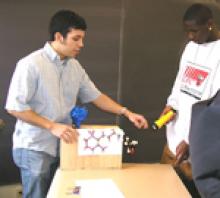
A molecular switch resembles an electronic switch we use to turn on and off lights. A molecular switch is a much, much smaller (nanoscale) "device" in which one biochemical partner controls the activity of another. Vision is one of many processes in your body controlled by a molecular switch.
Materials needed:
- 3 Colored Lights (Blue, Green, & Red)
- Vision Box
- Poster Paper (white)
- Dark Room preferably
The Demonstration:
Vision Box:
- Introduce the eye to everybody. You also want to start this off by talking about scale. Tell them to picture their eye, which is on the cm scale. Inside their eye are rods and cones, which are Microscale. Even smaller is the retinal molecule, which is located inside of the rods and cones; these are nanoscale. This introduction brings them into the eye; hold up the picture to help them picture the interior of the eye.
- Now that you have the participants familiar with retinal, introduce this molecule as a "molecular switch." You have a picture of retinal to use if you need it. Compare this switch to a light switch, which you turn on when you need light to see. Molecular switches obviously do not work in the same manner, however, in our eye, we need light to trigger the molecular switch.
- Have a participant use a flashlight to shine on the retinal molecule. When light is present, retinal changes configuration, it goes from "cis" to "trans". When retinal is in trans configuration, this is the switch that sends messages to the brain enabling you to see.
Color Mixing:
- At this point, you have already introduced cones. Tell the participants you are going to take a deeper look at cones and how they are responsible for vision. You may want to start out by asking what the three primary colors are. Remember, in optics these are red, blue, green and they are additive meaning when combined, they make white. In art, they are yellow, magenta, cyan or subtractive.
- Going back to optics, we have cones that represent the three primary colors: red, blue and green. Now, ask for volunteers among participants for color mixing. Have 3 for color mixing, 1 for white board, one for color mixer. Make sure the person holding the color mixer is no more than 2 inches from the white board. Also, make sure the people doing the color mixing shine their light in at an angle. You want the colors to overlap, however, you don't want the lights to shine directly on top of each other.
- Take turns here: red + blue = magenta, blue + green = cyan, green + red = yellow. red + blue + green = white. All colors seen by your eye are from overlaps of these three cones! If time permits, have the participants’ shine the colored lights on objects to predict what color the object will look like under the light. For example, use a person's blue t-shirt. Have them predict what it will look like with red light, green light, and blue light. Then, have them shine the lights to see if they were right.
Procedure Sheet: molecular_switches_procedure.pdf
Molecular Switches FAQs
A molecular switch resembles an electronic switch we use to turn on and off lights. A molecular switch is a much, much smaller (nanoscale) "device" in which one biochemical partner controls the activity of another. Vision is one of many processes in your body controlled by a molecular switch.
Cool Facts
- When light hits our eye it only takes a few trillionths of a second to turn the switch on!!!
- The switch in our eyes sends a real electric impulse to our brain, just like when you flip switch and it sends the electricity to a light bulb!!!
- You eye contains 100 million rods and 7 million cones!!!
- Our eyes only sense three different colors, Red, Blue, and Green. Our brain then combines those three colors for all the different colors we see.
A: The switches are located in two types of cells in our eyes, the rods and the cones. The rods and cones are given their names because the cells really look like rods and pine cones.
A: The switches are made of a chemical called Retinal. Retinal has two forms a cis form and a trans form. When the retinal is in the cis form the switch is turned off and when it is in the trans form the switch is turned on.
A: The switches work in both the rods and the cones. In both the rods and the cones the switch sits inside a well in a protein. When the switch is turned on it sends a signal through the protein that is interpreted by our brains.
A: The rods and cones have different functions in the eyes. The rods are responsible for vision in low levels of light while the cones are responsible for color vision and detail.
A: The switches themselves do not work differently, it is the protein that the switch sits in that is different. The protein in the rods is called scotopsin, while the proteins in the cones are called cone pigments.
A: When light hits the switch it converts it from the cis form to the trans form this causes an electrical impulse to be sent to our brains through nerve fibers that are connected to our eyes. The electrical impulse travels down the fibers to the primary visual cortex where the impulses are converted into what we see. Just like cable TV, electrical impulses are sent over wires to a TV where they are converted to visual images!!!
Molecular switches control many functions of our body. They allow us to see, the retinal “switches on” our vision and allows us to see color, without it, we and all other vertebrates are blind. Another molecular switch in our body controls our muscles, myacin tells our muscles to either flex (on) or release (off).

